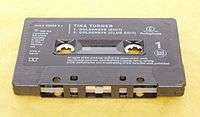Cassette single
A cassette single (CS, also known by the trademark "Cassingle" or capitalized as the trademark "Cassette Single") is a music single in the form of a Compact Cassette.
 | |
| Media type | Magnetic tape |
|---|---|
| Encoding | Analog signal |
| Capacity | Generally less than 10 minutes total (2-3 songs), sometimes repeated on both sides |
| Read mechanism | Tape head |
| Usage | Audio playback |

History
Bow Wow Wow's "C·30 C·60 C·90 Go" was the first cassette single, released in the UK in 1980,[1] and I.R.S. Records released the first cassette single in the U.S. with the Go-Go's "Vacation" in 1982.[2]
The ZTT label made good use of the format by 1984, with singles by Frankie Goes to Hollywood, Art of Noise and Propaganda being issued in unique versions on cassette.
American record companies began releasing cassette singles on a large scale in 1987, when vinyl record album sales were declining in favor of cassette recordings; the cassette single was meant to replace the 45 record in a similar way.[2]
The format was used as a promotion in the 1990s, with Disney giving a "cassingle" to attendees of Hercules promotional events.[3]
Packaging

Originally, most cassette singles were released in a cardboard sleeve that slipped over the outside of the release. This was then usually shrink wrapped in plastic. Some singles contained one song on each side, much as 45s had done, but others repeated the songs on both sides. In some markets, cassette singles generally used the same packaging as standard cassettes, a plastic box with a paper insert.
As the cassette maxi-single was released, more intricate packaging was incorporated that looked similar to the packaging of a regular cassette release. These were placed in regular plastic cassette cases with a paper/cardstock insert. Unlike a full-length cassette album, these were generally only one two-sided inlay instead of a fold-out. Maxi-singles usually contained four versions of a single song, i.e.: unique mixes & edits, but some contained versions of two different songs.
Popularity
Although the cassette had reached a high level of popularity by the late 1980s, due to the ubiquity of mobile devices such as the Sony Walkman, the boombox and car audio cassette players, cassette singles never rivalled gramophone records to even near the same extent as cassette albums had done. In the U.S., cassette singles were completely phased out by the mid 2000s. One reason for their lesser popularity was because they appeared to be an inefficient use of the media to consumers - a cassette single took up the same storage space as a full album. In April 2013, however, psychedelic rock band MGMT released the first single from their third album as a cassette single, and October 2014 saw the cassingle "Great Big Happy Green Moonface" from Polaris, the band's first release in fifteen years.
References
- Johnson, Bobbie (2006-10-19). "CDs, downloads ... and now band launches the memory-stick single". The Guardian. London. Retrieved 28 April 2010.
- Pareles, Jon (2 September 1987). "Cassette Singles: New 45's". The New York Times. p. C21. Retrieved 2 July 2009.
- "Billboard".